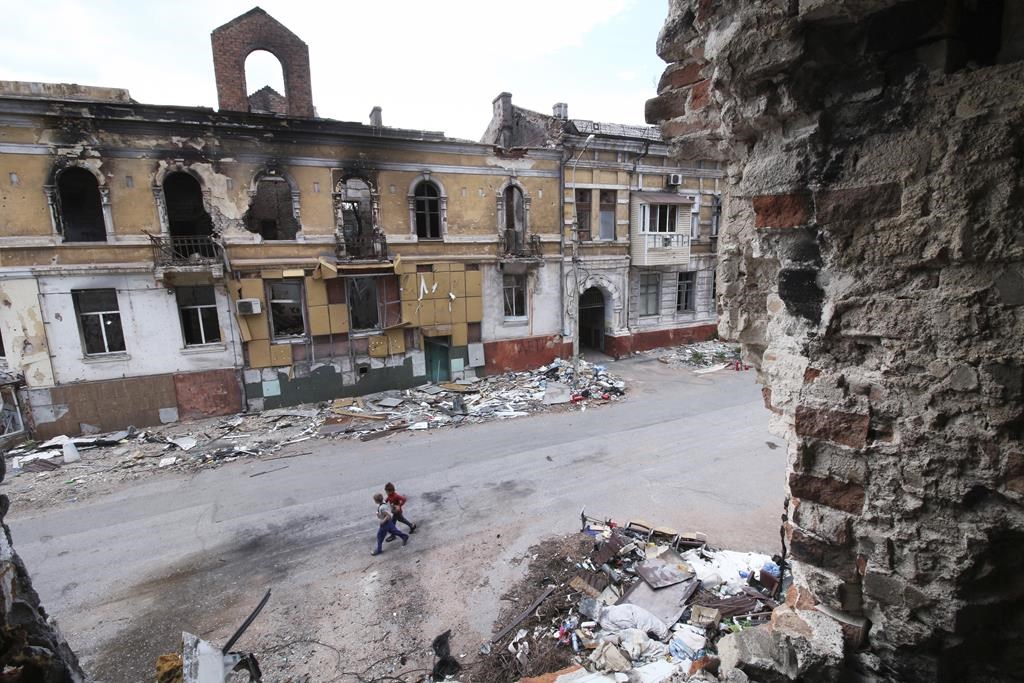The last time Kateryna Prokopenko spoke to her husband, in late May, the phone call lasted for just 13 seconds.

To the best of her knowledge, Denys Prokopenko — commander of the Azov Regiment, and one of the fighters who defended the Ukrainian city of Mariupol from Russian attacks — had been captured by Russian forces. He and thousands of other defenders had been taken into Russian-controlled territory in the Donbas region of eastern Ukraine, where they are being held as prisoners of war.
“He could only ask me how I am, and I answered everything was okay,” Prokopenko told Global News in an interview from Kyiv about that conversation with her husband.
“I asked how he was, and I did not get an answer because the connection was really bad. He did not hear me. I did not hear him. It was like that for half a minute. It was just horrible. … So as for now, I don’t have any information where he is now at.”
Nearly a month after that call, Prokopenko and other family members of men who defended Mariupol and were captured by Russian troops have received little information on their whereabouts or condition. Moscow has not commented, and Ukrainian and international governments have had little luck getting answers.
As the war drags on and attention shifts to new battlefields in the Donbas, those family members are working to ensure the Mariupol defenders aren’t forgotten, and to keep international pressure on Russia to release them.
“They were fighting for us, for our lives, for their own relatives, for the whole country, for the whole world,” Prokopenko said.
“So we need to fight for them as well.”

'Horrors and atrocities' in Mariupol
Mariupol, a port city in Ukraine’s southeast, was an early target in Russia’s war and was besieged for weeks. Tens of thousands of civilians are believed to have been killed, including women and children, while Ukrainian officials and residents say the city has been turned to “ashes.”
“No one expected that the enemy would have so much heavy arms (dropped) onto such a peaceful city,” said Mariia Netreba, whose husband is a member of the 12th brigade of the National Guard and is also believed to have been captured.

Get breaking National news
A lifelong resident of Mariupol, she says she stayed in the city and saw first-hand the “atrocities” carried out by the Russians until March 29 — over a month after the war began — when she finally fled to Kyiv.
“We just endlessly saw aviation (carrying) super heavy bombs, which were dropped against the residential blocks … killing people in approximately 15 buildings instantly,” she told Global News.
“Such horrors and atrocities were taking place there. It was a real genocide of the Ukrainian people.”

Some of the most well-publicized attacks on civilians took place in Mariupol. A maternity and children’s hospital was hit by an airstrike on March 10, killing pregnant women inside. A theatre sheltering about 1,300 civilians was bombed a week later, despite satellite photos showing the word “CHILDREN” written in Russian on the ground outside.
As Russian forces advanced into the city, thousands of Ukrainian fighters and civilians were forced into the Azovstal steel plant, a hulking complex with a vast array of underground tunnels that became the last stronghold for the Ukrainian resistance.
Attempts to evacuate civilians from the plant were undermined by Russian attacks, which also disrupted humanitarian corridors out of Mariupol as the city was encircled.
“Our guys … helped the civilians leave Azovstal and they were shelled,” said Tetyana Kharko, whose brother is a commander in the 36th Special Marine Brigade of Ukraine’s Naval Forces. At least three defenders were killed, according to the Azov Regiment.
“There was really hell on earth, because they dropped heavy bombs on them. … Those bombs were dropped onto field hospitals, where already there were wounded guys, wounded warriors who did not have hands or arms or legs. … The Russians understood where to drop those bombs, to kill even the wounded.”
On May 20, after weeks of shelling and airstrikes, the last of the defenders surrendered and Moscow claimed it now controlled all of Mariupol. The Russian defence ministry said more than 2,000 fighters were taken prisoners.
During that fierce fighting, family members who had long since fled to other parts of the country could only watch in hope, fear and admiration.
“I’m just out of words to describe their courage and reliability and what they showed (at Azovstal),” Netreba said.
In the weeks since the surrender, little has been revealed about the soldiers’ fate. Netreba says while it’s believed they were first taken to Olenivka, part of a Russian-controlled area of the Donbas, it’s possible they have since been moved elsewhere — including within the Russian Federation itself.
Ukrainian President Volodymyr Zelenskyy has said his government is working to secure their release, and European leaders have urged Russian President Vladimir Putin to let the fighters go. The International Committee of the Red Cross has been working to register the fighters in order to keep them in contact with their families, but have not released any new information.
The uncertainty has only made family members more worried.
“We don’t know if they’re being tortured, if they’re being given proper food and medical attention,” said Kharko.
“Day after day, we have had no (information) and we don’t have it still. So the emotional tension is increasing every day, and our patience is not limitless.”
'We don't have any choice' but to hope
Russian authorities have threatened to investigate some of the steel mill’s defenders for war crimes and put them on trial. President Vladimir Putin said in his Victory Day speech last month that his “special military operation” was aimed at rooting out “Nazis” and criminals in Ukraine, seizing on Azov’s past as a far-right regiment.
Lawmakers and pro-separatist leaders in the Donbas have even called for the fighters to face the death penalty, but it is not known if the Kremlin is actively exploring such a move.
“When Russia says Ukraine does not exist, that Ukraine has to be demolished, that Ukrainians have to be killed and tortured, that Ukrainian language does not exist — why are these statements not those of neo-Nazis?” Prokopenko asked.
Meanwhile, more than 200 bodies of fighters who were killed inside the Azovstal plant have been recovered and returned to Ukraine over the past two weeks, in swaps for bodies of Russian soldiers.
Prokopenko, Netreba and Kharko have no reason to believe any of the bodies are of their loved ones. But officials have said many of the bodies are unrecognizable, and have called for families to submit DNA samples to help identify them.
It remains unclear how many bodies might remain at the plant.
With no insight into how much longer they will have to go without answers, family members say they are left holding out hope they will one day be reunited. For them, it’s the least they can do.
“We don’t have any choice,” Kharko said.
“You cannot be just not doing anything, knowing that your relatives are heroes who are giving their health and lives for Ukrainian children, mothers, elderly people, women. You just cannot sit on your hands and wait until someone, somehow, brings them back.”
Prokopenko says the larger community of relatives and wives plan to hold several events to try and keep the Azovstal fighters’ plight in the public consciousness, ensuring they “are never forgotten.”
“We cannot be weak ourselves,” Netreba added. “I will fight until the end, until each of them comes home to their families.”










Comments